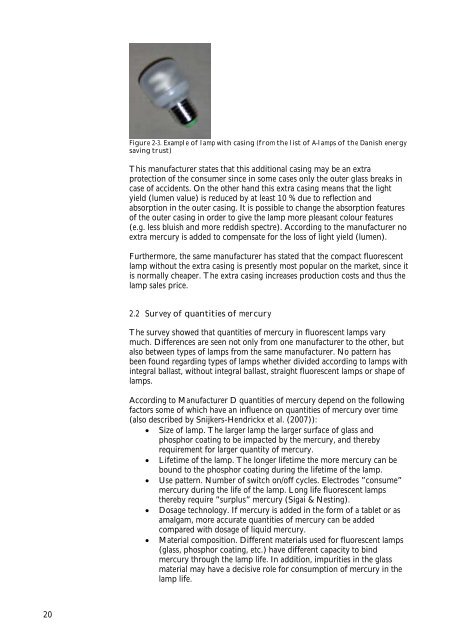No. 104 - Miljøstyrelsen
No. 104 - Miljøstyrelsen
No. 104 - Miljøstyrelsen
Create successful ePaper yourself
Turn your PDF publications into a flip-book with our unique Google optimized e-Paper software.
20<br />
Figure 2-3. Example of lamp with casing (from the list of A-lamps of the Danish energy<br />
saving trust)<br />
This manufacturer states that this additional casing may be an extra<br />
protection of the consumer since in some cases only the outer glass breaks in<br />
case of accidents. On the other hand this extra casing means that the light<br />
yield (lumen value) is reduced by at least 10 % due to reflection and<br />
absorption in the outer casing. It is possible to change the absorption features<br />
of the outer casing in order to give the lamp more pleasant colour features<br />
(e.g. less bluish and more reddish spectre). According to the manufacturer no<br />
extra mercury is added to compensate for the loss of light yield (lumen).<br />
Furthermore, the same manufacturer has stated that the compact fluorescent<br />
lamp without the extra casing is presently most popular on the market, since it<br />
is normally cheaper. The extra casing increases production costs and thus the<br />
lamp sales price.<br />
2.2 Survey of quantities of mercury<br />
The survey showed that quantities of mercury in fluorescent lamps vary<br />
much. Differences are seen not only from one manufacturer to the other, but<br />
also between types of lamps from the same manufacturer. <strong>No</strong> pattern has<br />
been found regarding types of lamps whether divided according to lamps with<br />
integral ballast, without integral ballast, straight fluorescent lamps or shape of<br />
lamps.<br />
According to Manufacturer D quantities of mercury depend on the following<br />
factors some of which have an influence on quantities of mercury over time<br />
(also described by Snijkers-Hendrickx et al. (2007)):<br />
� Size of lamp. The larger lamp the larger surface of glass and<br />
phosphor coating to be impacted by the mercury, and thereby<br />
requirement for larger quantity of mercury.<br />
� Lifetime of the lamp. The longer lifetime the more mercury can be<br />
bound to the phosphor coating during the lifetime of the lamp.<br />
� Use pattern. Number of switch on/off cycles. Electrodes ”consume”<br />
mercury during the life of the lamp. Long life fluorescent lamps<br />
thereby require ”surplus” mercury (Sigai & Nesting).<br />
� Dosage technology. If mercury is added in the form of a tablet or as<br />
amalgam, more accurate quantities of mercury can be added<br />
compared with dosage of liquid mercury.<br />
� Material composition. Different materials used for fluorescent lamps<br />
(glass, phosphor coating, etc.) have different capacity to bind<br />
mercury through the lamp life. In addition, impurities in the glass<br />
material may have a decisive role for consumption of mercury in the<br />
lamp life.

















